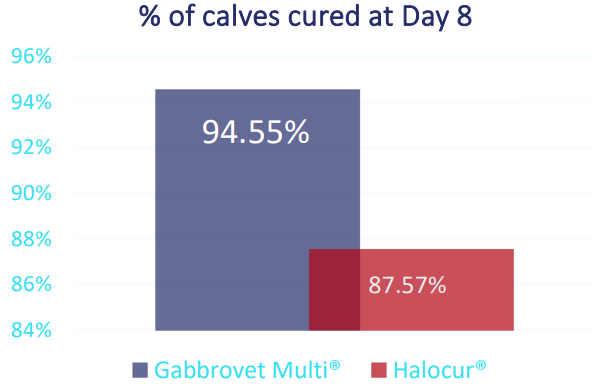Poster
Efficacy of an oral solution of paromomycin for the treatment of newborn dairy calves with cryptosporidiosis. Results from a comparative European multicentric field study
Authors
Damien Achard, Béatrice Besche-Barbazanges, Gaëlle Pagny, Jean-François Collin, Dejan Cvejić
Publication information
Ceva Sante Animale, Libourne, France Klifovet AG, Munich, Germany
OBJECTIVES
Cryptosporidiosis is a frequent parasitological infection of mammals including but not limiting to humans and neonatal ruminants. In newborn calves, cryptosporidiosis has been repeatedly identified as a major contributor of neonatal diarrhoea, a dominant calfhood disease with detrimental health and economic consequences.
Current treatment options for clinically affected newborn calves are limited. A recent meta-analysis work reported halofuginone and paromomycin as valuable oral treatment options while recognizing that halofuginone can present important safety issues and that data is insufficient to fully support the use of paromomycin (Brainard et al., 2020, 2021). To address this lack of evidence, a study under field conditions was performed in dairy newborn calves clinically affected by cryptosporidiosis comparing a new dose regimen of an oral paromomycin solution (Gabbrovet Multi®, Ceva Santé Animale) to a reference product based on halofuginone (Halocur®, MSD).
MATERIALS AND METHODS
A GCP compliant study was performed according to a blinded, randomized, positive controlled, multicentric design in 4 commercial farms located in Germany, Hungary, and Portugal. The farms enrolled had a recent history of cryptosporidiosis and complied with several conditions such as vaccination for BVDV and neonatal diarrhea. Each newborn calves in this study were required to meet
the following criteria for enrollment: age between 3-14 days, faecal score ≥ 2, negative rapid test for E. coli, coronavirus, rotavirus, and positive rapid test for C. parvum. Any calf that presented with diarrhoea for > 24 hours or that has been previously exposed to antibiotics, parasiticides or probiotics was excluded. Animals were randomly allocated to two treatment groups. Calves in group A received 150 mg paromomycin sulfate/ kg b.w., once daily, for 5 days by oral route while calves in group B were orally administered 100 µg halofuginone/ kg b.w., once daily, for 7 days. The following clinical and parasitological parameters were monitored at fixed times during the 21 days of the study: fecal score (0-3), general health observation (0-3), hydration score (0-3), oocyst counts (number of oocysts per gram of dry faeces), bodyweight and mean daily body weight gain (MDBWG). Percentages of calves cured at day 8 and MDBWG between day 0 and day 21 were the main criteria to evaluate the efficacy in both treatment groups. Other criteria such as parasitological cure at day 3, 5, 7, 14 and 21 and time to clinical cure from day 2 to day 8 were also assessed. The statistical unit was the calf and the 5% level of significance (p < 0.05 for two-sided tests) was used to assess statistical differences.
RESULTS
Three hundred thirty-four dairy calves, mostly Holstein-Friesians, with a mean age of 9.1 days and a mean body weight of 41.8 kg were enrolled in this study. 165 calves were allocated to treatment group A, 169 in the treatment group B. At inclusion, the treatment groups were found comparable.

94.6% (156/165) of newborn calves in group A and 87.6% (148/169) in group B were considered clinically cured by day 8. Clinical cure rate in group A was found superior to those observed in group B (lower bound of the 95% CI >0). In addition, MDBWG was higher for calves in group A in comparison to calves in group B, with a difference between groups of 0.0405 kg/day (p = 0.0086, best model); that is a bodyweight advantage of 850 g at the end of the 3 weeks follow-up period. Calves in group A were found to be cured faster in comparison to calves in group B. More precisely, the probability of healing first was 56.75% in favor of group A. The qualitative assessment of oocyst counts (positive / negative) assessed at each time point showed no significant difference, except on Day 7 (76.4% and 87.0% for negative calves in group A and B respectively). Overall, seven adverse events were documented from seven animals in group B but were not found to be related to the treatment.
CONCLUSIONS
In this European field study, daily oral treatment with 150 mg/kg of paromomycin (Gabbrovet Multi®) for 5 days was found safe and highly effective to cure sick dairy calves with cryptosporidiosis and to control their oocyst burden. In addition, this new treatment regimen was found superior to the current reference treatment based on halofuginone.
Don´t hesitate to read the rest of our publicatons and improve your knowledge about ruminats and their health!
Publication file:



